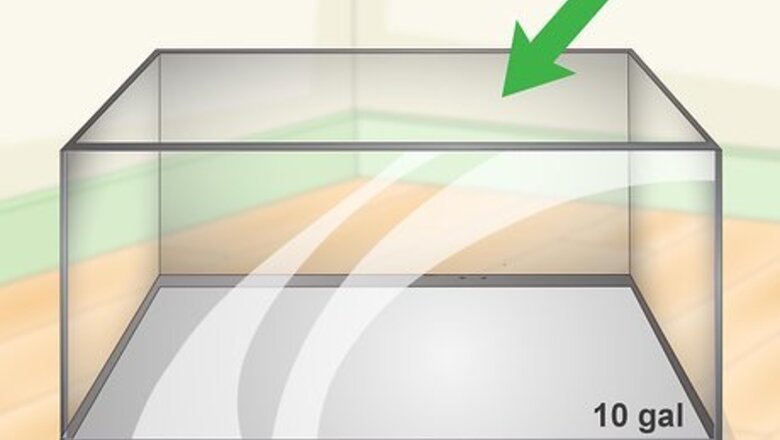
views
Picking a Cage
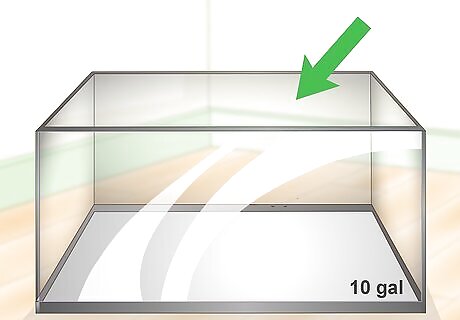
Choose a 10-gallon (38-liter) aquarium for the best option. A 10-gallon aquarium cage is suitable for two gerbils but should be bigger. Aquarium cages are ideal because they are spacious, great for digging, and easy to clean. Additionally, you can pile a large amount of bedding in the cage without it falling out and making a mess. The aquarium cage you choose should have a wire lid for ventilation and clamps to secure it on the cage. If you have three to four gerbils, then use a 15 to 20-gallon (57 to 76-liter) cage.
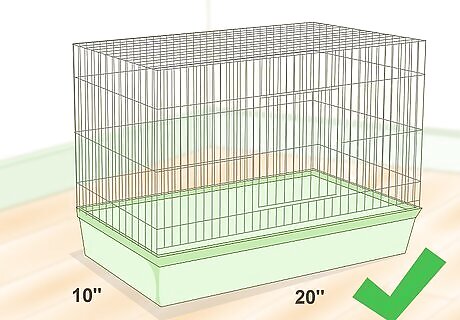
Try a wire cage for ventilation. Because wire cages are well ventilated, you may want to choose one if you live in a hot climate. A wire cage that is 10x20 inches (25.4x50.8 centimeters) is ideal for one to two gerbils. If you choose a wire cage, make sure the space between the bars is small to prevent your gerbil from escaping, about .2 to .4 inches (.5 to 1 cm) max. While a multi-level cage may seem ideal for your gerbils, it can be a hazard for baby gerbils. Baby gerbils are prone to fall and injure themselves in cages with multiple levels. Instead, go for a wire cage with a lot of tubes and tunnels.

Avoid plastic cages. Plastic cages or habitats have poor ventilation, which means you will need to clean them more often. Additionally, gerbils tend to chew holes into plastic cages. This makes plastic cages easy to escape from. Although plastic cages are popular, they are not gerbil-proof.
Positioning the Cage
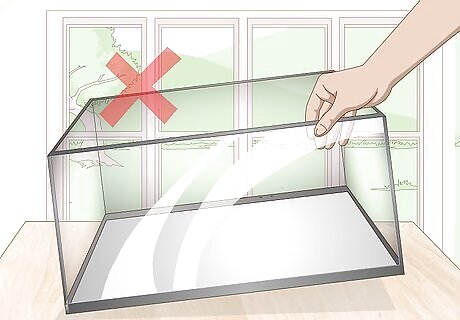
Avoid placing the cage near windows. Direct sunlight from windows can cause your gerbil’s cage to overheat, especially aquarium cages. Overheating can cause heatstroke in your gerbils. Instead, place your gerbil’s cage in a cool part of the house. A spot that receives indirect sunlight is ideal.
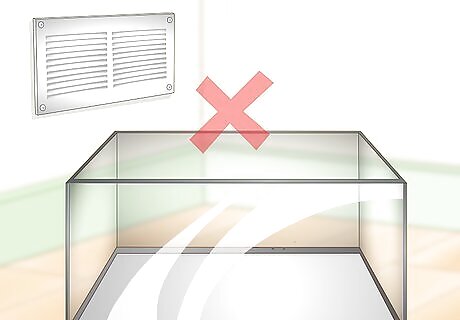
Avoid placing the cage in front of or underneath air vents. Additionally, do not place the cage in front of an air conditioning unit. Cold air that is constantly blowing on your gerbil’s cage can cause it to develop a cold.

Place the cage on a table or shelf. This way the cage will be off of the ground. Placing your gerbil’s cage on top of a structure will protect it from other pets like cats and dogs. Make sure the structure that you place the cage on is sturdy. If you are unsure about its sturdiness, then use a different structure. A cage that is placed on the ground is also prone to drafts.
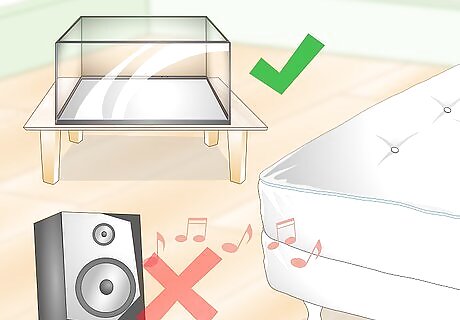
Put your gerbil's cage in a quiet room. Gerbils have an excellent sense of hearing and smell. Ideal spots for your gerbil's cage are quiet bedrooms, reading rooms, and studies. Avoid placing its cage in children's bedrooms, family rooms, kitchens, and hallways.
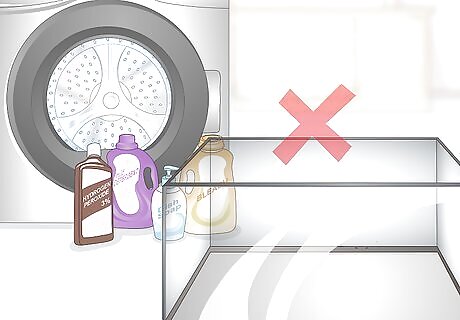
Avoid placing its cage in areas of the house where chemicals are stored. Do not place your gerbil's cage in laundry rooms or bathrooms. It is also not a good idea to put your gerbil's cage in the garage.
Organizing the Cage
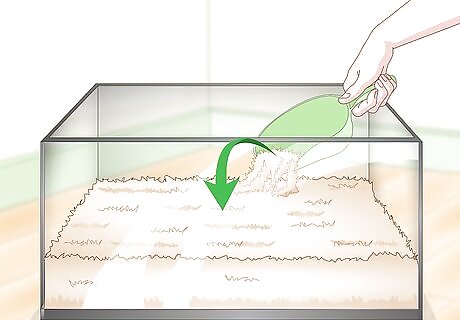
Fill the cage with 4 inches of bedding. Because gerbils like to dig and burrow, a cage that is filled with at least 4 inches of bedding is ideal. In some areas, you may want to fill half of the cage with bedding, if not more. A large amount of bedding will also allow your gerbil to bury its food. Use absorbent bedding such as recycled paper bedding or dust-free Aspen shavings. Avoid pine and cedar shavings since the fumes are harmful to gerbils. You can also use plain, shredded paper that does not have any newsprint on it. Once you put your gerbil in its cage, scoop out any soiled bedding as soon as you notice it, as the ammonia from urine can make your gerbil develop respiratory issues.
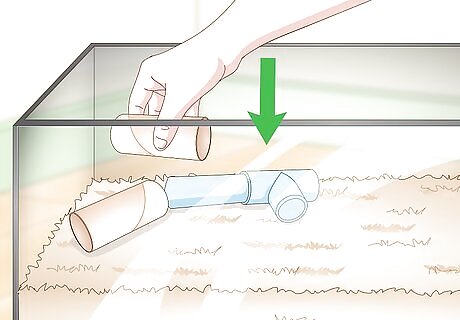
Position tunnels throughout the cage. Use toilet paper rolls, paper towel rolls, empty oatmeal containers, shoeboxes, and tissue boxes as tunnels. Bury the tunnels in the bedding throughout the cage. You can either bury them fully, or bury them halfway in the bedding. You can also purchase attachable tunnels for the cage. Avoid using wax-coated cardboard since the wax can be harmful to gerbils.

Use a thick, wooden box for a nest. Gerbils enjoy nesting boxes to sleep and hide in. Place bedding or shredded paper towels in the nest. Avoid fluffy material since this can wrap around your gerbil's feet and cause an injury. You can find wooden nesting boxes at your local pet supply store. Since gerbils can chew through plastic, avoid using a plastic nesting box.

Place wooden platforms in the cage. Because gerbils like to climb and explore, wooden platforms are a great way to keep your gerbil entertained. Make sure to place a wooden ramp next to the platform so your gerbil can reach it. Additionally, place flat stones or rocks in the cage. Gerbils like to climb on these and use them as lookouts.

Scatter its food throughout the cage. Place your gerbil's food in different spots throughout the cage. Scattering its food will encourage foraging, a natural behavior in gerbils. You can also place its food in a ceramic dish instead of scattering it. If you choose to use a ceramic dish, make sure the dish is heavy so your gerbil cannot tip it over.
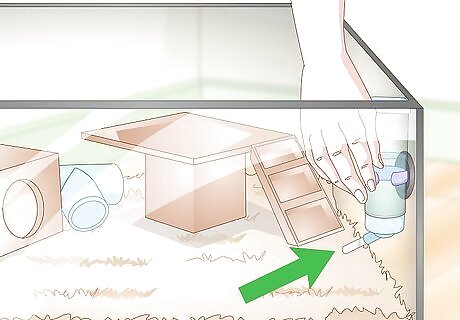
Attach a water bottle to the side of the cage. Make sure the water bottle’s tip is not near or touching the bedding. If it is, this may cause the water to drain out onto the bedding. You will need to change out the bedding if this happens. Refill your gerbil's water bottle with cool water daily. This way your gerbil will have access to fresh, clean water every day.
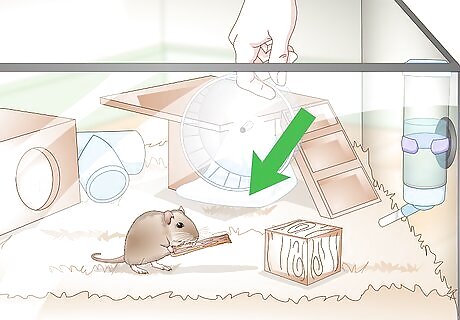
Provide multiple toys. Place wooden chew toys throughout the cage. Plain cardboard, wicker baskets, or branches from apple, cherry, and oak trees also make great chew toys. If you want to provide an exercise wheel, avoid using open-wire wheels. Your gerbil's tail can get caught in an open-wire wheel. Instead, use a wheel with a solid wooden, metal, or plastic running track. Make sure the wicker basket has not been treated with chemicals, dyes, or glue. You should also ensure that the branches are natural and have not been treated with herbicides, pesticides, or other chemicals. Pick fresh branches rather than dead ones off the ground.




















Comments
0 comment